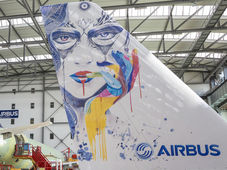
Airbus devises a new method for application of large scale liveries on aircraft
Toulouse, September 11, 2014 (STAT):-Airbus has developed a new method which employs direct inkjet printing to deliver a broad range of production and operational improvements in the application of complex, large scale liveries on aircraft. The method was developed by engineers from Airbus’ A320 Family paint shop in Hamburg, Germany, and is able to reproduce […]

Toulouse, September 11, 2014 (STAT):-Airbus has developed a new method which employs direct inkjet printing to deliver a broad range of production and operational improvements in the application of complex, large scale liveries on aircraft.
The method was developed by engineers from Airbus’ A320 Family paint shop in Hamburg, Germany, and is able to reproduce any livery design – be it a photographic motif, modern art or other complex patterns – faster and more efficiently than traditional painting processes, and with finer detail as well.
The direct printer functions much like a traditional model, using an inkjet head with nozzles that spray three basic colours (cyan, magenta and yellow) and black. Utilising a seven-square-metre bench, the inkjet head prints a design line by line, from top to bottom. After the process is completed, the aircraft component is sealed with a clear coat.
According to technology manager Matthias Otto, the advantages of direct inkjet-printed liveries are numerous. “I can create colour gradients or photo-realistic motifs that could never be achieved with paint,” he explained, and added that this new method also is capable of printing components of any size or shape. In the past, heavier printed film was used to produce complex designs, however such film is susceptible to the effects of heat, cold and high pressure, and ultimately could tear or peel.
The business case for direct printing is convincing. Compared with painting, where the design has to be built up by layer-by-layer, there are far fewer working and drying steps – greatly reducing the lead time. There also is no overspray or solvent vapour when ink is used, providing better working conditions for Airbus employees, as well as a healthier environment.
At present, the inkjet method still is at the experimental stage. Technical Readiness Level 6 (TRL 6) was reached at the end of June, and the ink and associated processes will be qualified early in 2015. Nonetheless, the project already has become part of the A320 Final Assembly Line (FAL) benchmark initiative, with the intention to further stabilise scheduled lead times for the best-selling Airbus single-aisle jetliner family.

